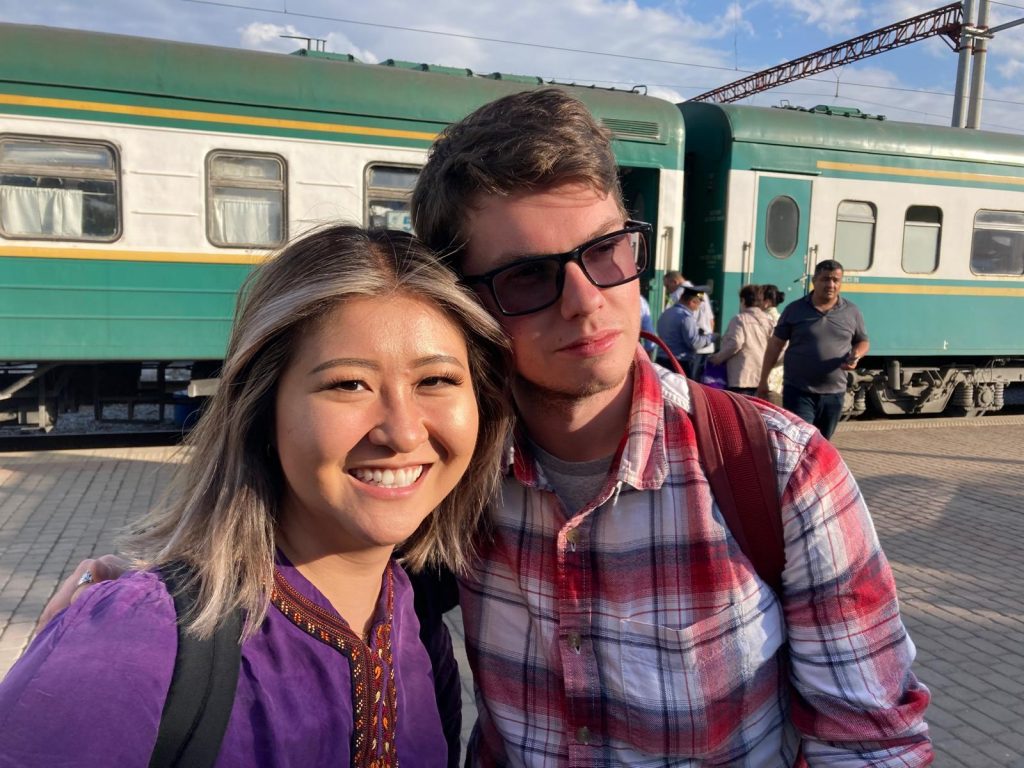For someone who comes from the country that supposedly invented rail transportation, it’s depressing how bad the UK’s train network actually is.
By now, I have lost track of the number of friends who have arrived for their first trip – with high expectations of a sophisticated and efficient society – only to have this shattered as soon as they hop onto a British train. Often, they look at me with a face that looks somewhere between having just sucked a lemon and seeing a nun getting punched in the face.
The nation’s inability to run an efficient and affordable service anywhere outside of Central London is nothing short of embarrassing.
So, when I moved to Central Asia last year, I was extremely surprised to see that Uzbek trains are part of one of the most thorough and efficient networks in the world. This is even more surprising when considering that, barely five years ago, Uzbekistan was one of the most isolated and economically dysfunctional countries on earth.

In the last 18 months, I’ve made 8 trips to every corner of the country. On each occasion, the train network played a major part in my trip… and in a very positive way.
Here is your comprehensive guide to the Uzbek train network, its strengths and flaws, and how to best utilize it on your next Uzbekistan adventure.
Table of Contents
A (brief) history of Uzbek trains:
Trains first came to what is now Uzbekistan during the late 19th century, when the Russian Empire expanded into Central Asia. The first major railway was built in the 1880s, which connected Tashkent with other major cities.
Soviet rule caused a significant expansion of the railway system. As in many socialist countries, it became a key component of the nation’s public transit system. Following independence in 1991, Uzbekistan continued developing its rail system. This was even as the country’s economy “fossilized” between 1991 and 2016 under the premiership of Islam Karimov.
One of the few modern (and most impressive) projects of the Karimov era was the construction of a high-speed train line. In 2011, the “Afrosiyob,” service commenced. Using Spanish-built high-speed trains, Tashkent was connected to the ancient Silk Road city of Samarkand. The track was extended in 2016 to serve Bukhara, the other “jewel” of the country’s tourist circuit.

Today, the Uzbek train network is a mix of high-speed lines and reliable Soviet sleeper trains. There is almost nowhere in the country that cannot be reached by train in less than 24 hours. Furthermore, other overland options are rarely as quick as taking the train, and the cost of flying often makes than uncompetitive.
Uzbekistan also benefits from a high population density and flat topography, which makes train travel much easier (and quicker) compared to its neighbours.
What’s this talk of a high-speed network?
As mentioned, there is an excellent high-speed network that connects Tashkent, to the ancient Silk Road cities of Samarkand and Bukhara. One can now travel from the capital to Bukhara, over 600 kilometres, in under four hours.
Thankfully for tourists, this network connects the “golden triangle” where most visitors stay, which is a shame. However, an extension to the desert settlement of Khiva – my favourite place in Uzbekistan – is set to open by next year. This will slash travel times from Tashkent down to seven hours, instead of the current fourteen.

The high-speed network is known as the Afrosiyob. This name originates from the ancient site north of Samarkand, an area now considered the cradle of ancient Sogdian civilization.
How “luxurious” is it?
Like many questions, it depends on what your own definition of “luxury” is. Both the Afrosiyob, Sharq, and Sleeper trains have three different categories for travel.
On the Afrosiyob, these are known as VIP, Business and Economy, while Sharq offers a (day) sleeping option alongside First and Second class. The Sleeper trains offer 2 and 4-bed “soft-sleeper” compartments, as well as open 6-bed “hard sleeper” carriages.
To avoid confusion, it is very common to take the “sleeper” train for journeys that do not involve overnight travel. For example, the train from Nukus to Tashkent does indeed involve an overnight section, but boarding the train in Bukhara means you will only travel during the day. In this case, you can either nap on your bed or convert it into a desk and seat.
The Afrosiyob service is akin to anything similar in Western Europe (except for the price!) while the Sharq is perhaps a touch below this. Both contain dining carts, power sockets, and air conditioning as standard.
And while the Sleeper service may be “Soviet,” the trains have had a bit of an upgrade since the Berlin Wall fell.
Yes, the six-berth carriages are hardly luxurious, but the bedding has always been spotless, and there isn’t a drinking culture on them that often disrupts your sleep in other countries. The toilets are clean and, while there are no showers, there is hardly a need given the size of the country.
Dining carts are hit-and-miss, although there are frequent stops to purchase snacks and meals. Please note, however, that only the 2 and 4-bed carriages include air-conditioning – which I learnt at my peril while travelling on Uzbek trains during the summer.

Personally, however, the biggest “luxury” of the sleeper trains is the people you will meet.
Uzbeks are ridiculously friendly, and you would have to try really hard to avoid engaging in conversation with anyone. While being a Russian speaker makes things easier, there’s nothing that Google Translate and Babushkas offering you copious amounts of snacks can’t fix. After an overnight train from Tashkent to Nukus, I had several invites to people’s houses… and even one to a wedding.
How can I purchase a ticket?
Thankfully, Uzbekistan has come a long way from just a few years ago, when purchasing any ticket involved a trip to the station and handing over a carrier bag with Uzbek Sum bills.
You can still purchase tickets at the station, but the online booking system from Uzbekistan Railways is highly recommended. There is an English option and a decent app, although sometimes city names switch into Cyrillic for no reason. The ticket will then be saved as either a PDF ticket with a barcode, which you can choose to print, or else as a QR code in the app.

You pay online using foreign credit cards, with the price being charged in your own currency. They even accept American Express!
Is it expensive?
The Uzbek train network is ridiculously good value for money, especially for foreign visitors.
Tickets do not change in price depending on when or how far in advance you buy them. A one-way economy ticket on the Afrosiyob costs 403,000 sum from Tashkent to Bukhara – around $32 as of October 2024.
For a sleeper ticket from Andijan to Nukus, it is 290,000 sum in a six-berth cabin. That is less than $23 to travel the length of the country, and not have to pay for a bed for the night!
The price also includes as much luggage as you can carry! There’s no limit on the number of cases that you can be put on the train, unlike in countries such as Japan.
How far ahead should I book?
In short, as far ahead as you can!
Bookings open 2 months ahead of travel. However, especially for Afrosiyob trains, you will notice that trains book up almost immediately. This is due to large tour companies booking seats en masse as soon as they become available, which is controversial in Uzbekistan.
Generally, you should book at least 1 month ahead for the Afrosiyob, 2 weeks ahead for the Sharq and 1 week ahead for the Sleeper train. However, always bear in mind that Spring and Autumn are the “peak seasons” in Uzbekistan. When booking Uzbek trains, you should also consider major holidays such as Navruz and Eid.

Uzbekistan Railways also allows fee-free cancellation until an hour before departure. This is, surprisingly, both a good and a bad thing. While it allows you maximum flexibility, it also has the unintended consequence of people booking multiple tickets, only to cancel most of them at the last minute.
As such, if your travel plans are flexible, you may get lucky by refreshing the app or website in the hours before a train… as I have done, anxiously, several times.
What about international trains?
Uzbekistan does have some international train routes that connect the country with its neighbours, although they are somewhat limited.
Notable connections connect Tashkent to Almaty and Astana in Kazakhstan, both taking around 18 hours. You can connect to Bishkek by taking the train to Almaty but changing at Shymkent, although the 12-hour bus journey takes about half as long.
These trains run (generally) every other day and are always Sleeper services.
Long-distance services also connect Tashkent to Moscow and Volgograd, although these mainly cater to Uzbekistan’s many economic migrants going to Russia. A once-weekly train from Dushanbe to Tashkent may also be of interest – this takes 18 hours, via Samarkand.
So… how do I make this adventure happen?
Being the experts in both Central Asia and train travel of all kinds, YPT is in a great position to make your Uzbekistan adventure possible! We visit this amazing country on several of our group tours throughout the year.
However, if you have a particular interest in train travel, want a more bespoke experiance, or just want to take full advantage of the Uzbek train network, then we can craft a personalized itinerary for you!
We look forward to seeing you on the line!





